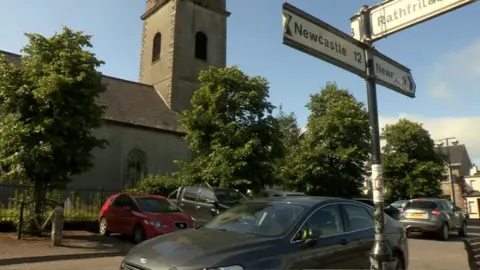Historic buildings to be saved from disrepair
 BBC
BBCOnce centres of family life, employment, learning and worship, but now falling into wrack and ruin.
Every town has beautiful old buildings that have fallen on hard times.
It is estimated that there are about 500 historic buildings across Northern Ireland that are at risk of falling into a state beyond repair.
They include castles, churches, schools, homes and mills.
There is no doubting their beauty, but finding a new use for them can prove challenging.
A new three-year pilot scheme launched by the Department of Agriculture, Environment and Rural Affairs and the Department for Communities aims to restore four of these buildings while putting them into community control.

Helping them is the Architectural Heritage Fund (AHF), which aims to find sustainable uses for buildings at risk in areas of deprivation.
AHF spokeswoman, Rita Harkin, says the chosen buildings are in counties Down, Tyrone, Fermanagh and Antrim.
"We are working with four groups in the villages to address the needs of people who are suffering from issues associated with rural poverty and social isolation," she said.
The four buildings are:
- Gracehill Old Post Office, County Antrim;
- Pat Murphy House, Ederney, County Fermanagh;
- Church of Ireland, Hilltown, County Down;
- Woolstore, Caledon, County Tyrone.
Gracehill is being restored in partnership with the Now Group, a social enterprise working with young adults with learning difficulties and autism.
The Pat Murphy House will become a wellbeing hub and co-working space, the Church of Ireland in Hilltown will become a flexible working space, while the Woolstore in Caledon will become a childcare facility.
Dr Marie Cowan, Clonduff Development Enterprise, said the Hilltown community has been putting forward ideas for how it would like to see the 250-year-old former Church of Ireland building in the centre of the village transformed.
"It was one of the original buildings in the village alongside the hotel," she said.

"So we want to see the restoration of this unique built heritage and then potentially a hub or centre for community use, for services, for cultural and arts, for the environment and tourism information."
Neil Galway, a lecturer in planning at Queen's University, said the delivery of the projects could lead to further regeneration.
"If you come from a place that is blighted by dereliction, by vacancy, by lack of investment, that impacts the identity and perception of local residents," he said.
"It offers an opportunity for communities to come together an devise uses for buildings that will benefit them into the next century."
If the pilot proves successful, it is hoped that more money will be made available for further restoration work elsewhere.
